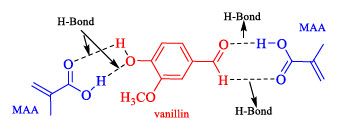Synthesis and Evaluation of Molecularly Imprinted Polymer As a Selective Material for Vanillin
Keywords:
Vanillin, Molecularly imprinted polymer, Selective materialAbstract
Molecularly imprinted polymers (MIPs) using vanillin (Val) as a template molecule were synthesized and evaluated. MIPs were prepared by precipitation polymerization using various types of functional monomers with using ethylene glycol dimethacrylate (EGDMA) and trimethylolpropane trimethacrylate (TRIM) as cross linkers and polymerization was done at 80°C for 6 h. The binding efficiency of polymers was evaluated including types of monomers, binding time and reusability. Results showed that methacrylic acid was the selective monomer for vanillin and the highest performance of MIPs, which including the binding efficiency and selectivity, was obtained when bound polymer with vanillin for only 2 h and could be reused as least five times.
References
Ansell, R. J. (2015). Characterization of the binding properties of molecularly imprinted polymers. Advances in Biochemical Engineering/
Biotechnology, 150, 51-93.
Borges da Silva, E. A., Zabkova, M., Araujo, J. D., Cateto, C. A., Barreiro, M. F., Belgacem, M. N., & Rodrigues, A. E. (2009). An integrated process to produce vanillin and lignin-based polyurethanes from Kraft lignin. Chemical Engineering Research and Design, 87(9), 1276-1292.
Diouf, A., Motia, S., El Alami El Hassani, N., El Bari, N., & Bouchikhi, B. (2017). Development and characterization of an electrochemical biosensor for creatinine detection in human urine based on functional molecularly imprinted polymer. Journal of Electroanalytical Chemistry,
, 44-53.
Esposito, L. J., Formanek, K., Kientz, G., Mauger, F., Maureaux, V., Robert, G., & Truchet, F. (1997). Vanillin. In Kirk-Othmer Encyclopedia of chemical technology. New Jersey: John Wiley & Sons.
Hong, Y., & Chen, L. (2013). Extraction of quercetin from Herba Lysimachiae by molecularly imprinted-matrix solid phase dispersion. Journal of Chromatography B, 941, 38-44.
Kantarovich, K., Belmont, A. S., Haupt, K., Bar, I., & Gheber, L. A. (2009). Detection of template binding to molecularly imprinted polymers by Raman microspectroscopy. Applied Physics Letters, 94, 194103.
Karuehanon, W., Lee, V. S., Nimmanpipug, P., Tayapiwatana, C., & Pattarawarapan, M. (2009). Synthesis of molecularly imprinted polymers for nevirapine by dummy template imprinting approach. Chromatographia, 70, 1531-1537.
Karuehanon, W., Wongthep, T., & Wanggnorn, C. (2018). Synthesis of molecularly imprinted polymers for extraction of quercetin from
mulberry leaves. Prawarun Agricultural Journal, 15, 96-103.
Lee, J. S., Oh, J., Kim, S. G., & Jang, J. (2015). Highly sensitive and selective field-effecttransistor nonenzyme dopamine sensors based on Pt/conducting polymer hybrid nanoparticles. Small, 11, 2399-2406.
Mayes, A. G., & Whitcombe, M. J. (2005). Synthetic strategies for the generation of molecularly imprinted organic polymers. Advanced
Drug Delivery Reviews, 57(12), 1742-1778.
Mohamad Ibrahim, M. N., Sipaut, C. S., & Mohamad Yusof, N. N. (2009). Purification of vanillin by a molecular imprinting polymer technique. Separation and Purification Technology, 66, 450-456.
Mokgadi, J., Batlokwa, S., Mosepele, K., Obuseng, V., & Torto, N. (2013). Pressurized hot water extraction coupled to molecularly imprinted polymers for simultaneous extraction and clean-up of pesticides residues in edible and medicinal plants of the Okavango Delta, Botswana. Molecular Imprinting, 1, 55-64.
Wu, J., Yang, Z., Chen, N., Zhu, W., Hong, J., Huang, C., & Zhou, X. (2015). Vanillinmolecularly targeted extraction of stir bar based on magnetic field induced selfassembly of multifunctional Fe3O4@ Polyaniline nanoparticles for detection of vanilla-flavor enhancers in infant milk
powders. Journal of Colloid and Interface Science, 442, 22-29.
Wulff, G. (2002). Enzyme-like catalysis by molecularly imprinted polymers. Chemical Reviews, 102, 1-27.
Xu, Z., Yang, Z., & Liu, Z. (2014). Development of dual-templates molecularly imprinted stir bar sorptive extraction and its application for the analysis of environmental estrogens in water and plastic samples. Journal of Chromatography A, 1358, 52-59.













